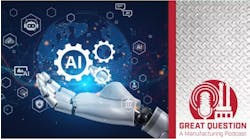The successful bridging of digital strategy to ROI-proven implementation is highly dependent on the people part of the organization.
In reviewing the Smart Industry 2019 State of Initiative, 5 of the top 10 obstacles to digital transformation are related to people. McKinsey, in Unlocking Success in Digital Transformations, presents 21 best practices from respondents who do report success. The headline? “We found that companies with winning transformations have a better funded and more robust approach to talent than others do.”
And as reported in Deloitte’s 2019 Human Capital Survey, the shift from a hierarchical structure to team-based structure is well underway. Key findings show that 31% of respondents operate mostly or wholly or almost mostly on teams and another 65% saying they are mostly hierarchical but with some cross-functional, team-based work.
This approach to getting things done demands a strategy that employs data-smart people.
A Harvard Business review article on collaborative overload presents the following supportive data points:
- Time spent by managers and employees in collaborative activities has ballooned by 50% or more.
- In most cases, 20% to 35% of value-added collaborations come from only 3% to 5% of employees. As people become known for being both capable and willing to help, they are drawn into projects and roles of growing importance.
- A recent study led by Ning Li, of the University of Iowa, shows, a single “extra miler”—an employee who frequently contributes beyond the scope of his or her role—can drive team performance more than all the other members combined.
Collaboration and high engagement rule the digital day
One conclusion we can safely draw here is that a highly collaborative environment in an organizational climate of high engagement (where “extra milers” are the norm) will deliver superior business results.
To create that environment for success, industry needs more talent-optimizers who can introduce fundamental change to the people side of performance…where talent strategy is just as important to success as financial, marketing or operational strategies.
Talent-optimizers can be found throughout companies, across businesses, and at every level. They place a premium on people. The hallmarks of talent optimizers include:
- Devoting significant attention to the talent implications of the (digital) business strategy
- In reviewing crucial roles and jobs, moving beyond legacy position descriptions and define behavioral and cognitive needs precisely
- Understanding that engaging a talent base is not a linear process, where it simply starts and ends.
- Being vigilant in creating awareness and sight into the four forces of disengagement.
Four forces of disengagement
Source: The Predictive Index
The first force is misalignment with the employee and the role they were hired for, moved into, or promoted to. Such job-fit problems can be common in dynamic, innovative environments. Most people can be taught the skills needed to adapt, but this force becomes unstoppable when the job/role is misaligned with an employee’s natural behavioral drives and traits.
Next up—the manager. When managers are ill-equipped to lead, coach and inspire they become an unintentional and powerful force of disengagement. Enough said here. We have all had these kinds of managers in our careers. How did they affect your desire to “extra mile”?
The third force of disengagement is related to teams. This is a big one given the continuing shift to collaboration. Conflict and poor communication can greatly decrease productivity. Teams that are misaligned fail to develop the cohesion necessary to both engage and generate results.
The fourth force of disengagement is culture. When employees are misaligned with their corporate culture, they lack meaning, purpose and trust. Misalignment here can create a profound feeling of isolation and loneliness, which can lead to disengagement.
Analytics is central word in the digital-transformation discussion. Analytics also applies to people in the modern workforce. To sustain success, we must have a clear understanding of the factors that increase employee engagement and drive performance. Working at the intersection of digital strategy and talent strategy requires (here’s that word again) strong collaboration between the CEOs and the chief human resource officer.
I suspect most readers don’t have either of those titles. This does not preclude you from defending against the four forces of disengagement in your primary area of work and, in doing so, assuming more personal responsibility for the success of the entire enterprise while positively affecting the teams and cross-functional leaders with whom you collaborate.
Tony D'Avino is principal and client resource with Topline Search, LLC.


